Longshan Grottoes
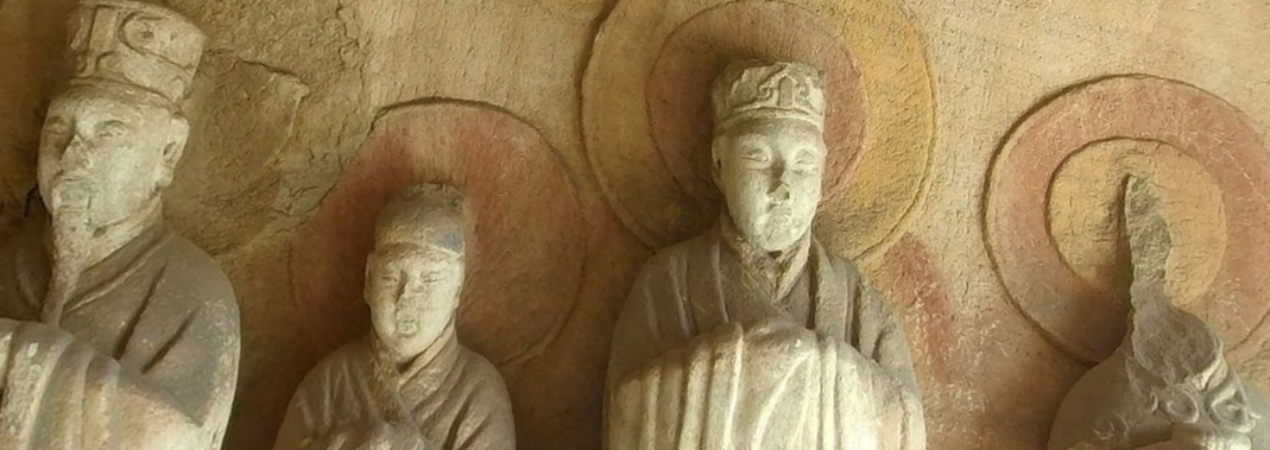
The Longshan Grottoes are on top of Longshan Mountain. The mountain is 20 kilometers southwest of Taiyuan City in Shanxi Province. These grottoes are different from the famous Tianlongshan Grottoes. They are Taoist grottoes. There are nine caves in total. Caves 1, 2, 3, 6, and 7 were built by Piyunzi Zhenren (named Song Defang) during the Yuan Dynasty. The others were built later during the Song Dynasty. But the statues in the two caves, Caves 8 and 9, have all been destroyed. So only seven grottoes can be visited. These seven grottoes have 66 Taoist stone statues. Despite having only seven grottoes, the Longshan Grottoes are still called "China's largest Taoist grotto complex," which shows both the great value and extreme rarity of Taoist grottoes.
- Chinese name:龙山石窟 Lóngshān Shíkū
- Recommended Duration: 1-2 hours
-
Entrance Fee:
Peak season (April to October) RMB 20
Off-peak season (November to March) RMB 15
-
Opening Hours:
Summer:8:30—17:30(17:00 stop selling tickets)
Winter:9:00—17:00(16:30 stop selling tickets)
- Best time to visit: November to March
- Address: Longshan Mountain, 20 kilometers southwest of Jinyuan District, Taiyuan City, Shanxi Province
- How to get there:Take bus route 308 and get off at 'Jinyang Avenue Jinxian Street Intersection', then walk about 900 meters to see the sign for Longshan Scenic Area
Highlights of Longshan Grottoes
Cave 1
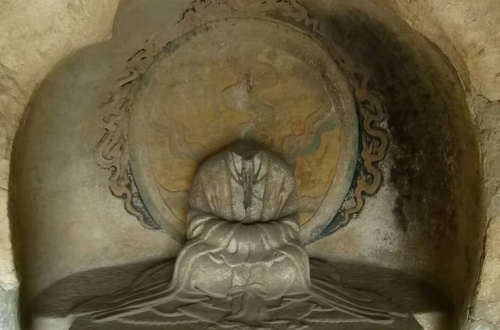 The statue of Xuhuang
The statue of XuhuangCave 1, also called Xuhuang Cave, is a circular cave with 21 statues. In the middle stands Xuhuang, the god of the void. On the stone walls on both sides are 10 statues of ancestors. The top of the cave is carved with a coiled dragon. The word Xuhuang means "there is an emperor in the world, and there is Xuhuang in the fairy world". This Xuhuang is the incarnation of Laozi. Cave 1 is the highest and is connected to Cave 2 below through a hole in the top of the cave. It can provide light for Cave 2 and connect Cave 1 above. However, since the steps built in the scenic area only reach the height of Cave 2, visitors need to look up to barely see the coiled dragon statue on the top of Cave 1.
Cave 2
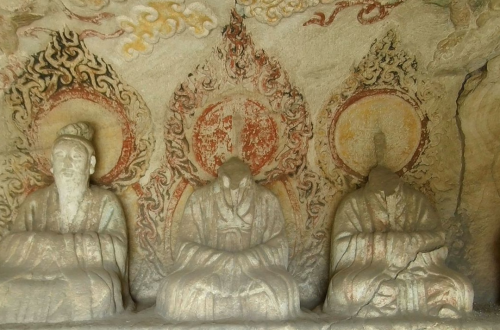 The statue of Sanqing
The statue of SanqingCave 2 – called Sanqing Cave – is the biggest in Longshan Grottoes. Inside are statues of the Sanqing and Liuyu. The Sanqing, Taoism's highest deities, are carved in the center. Taiqing Daode Tianzun is on the right, Yuqing Yuanshi Tianzun in the middle, and Shangqing Lingbao Tianzun on the left. They stand for the three forms of "Dao". Flanking the Sanqing are the Liuyu: the Jade Emperor, North Star Emperor, Longevity Emperor, Earth Empress, Polaris Emperor, and Eastern Salvation Emperor. They help the Sanqing run the world. There's also a fine five-dragon relief on the cave's top.
Cave 6
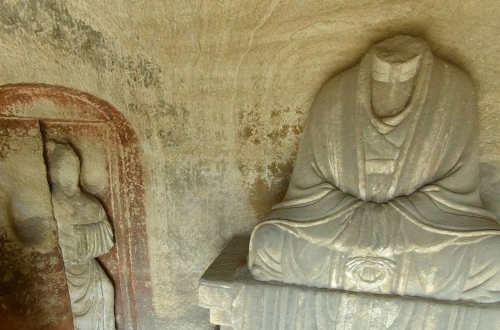 The statue of Piyunzi
The statue of PiyunziCave 6, Piyunzi Cave, was made by Song Defang for himself. His disciples Qin Zhi'an and Li Zhiquan stand beside his statue. A wall carving shows a boy with scriptures, listening to Song teach behind a half-open door. The walls have well-kept eulogies praising Master Piyun's deeds. They give real looks at Yuan Dynasty Taoist life and are key for studying its culture. On the ceiling, two finely carved phoenixes fly through clouds, their curves flowing like Tai Chi.
Cave 7
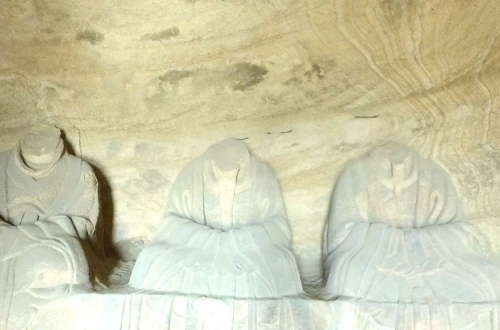 The statue of Seven Masters of Quanzhen
The statue of Seven Masters of QuanzhenCave 7 is the Seven Masters of Quanzhen Cave. It is divided into two rooms, the inner and outer rooms, with 8 statues. The inner room is the stone statues of the Masters of Quanzhen - Ma Yu, Tan Chuduan, Liu Chuxuan, Qiu Chuji, Wang Chuyi, Hao Datong and Sun Buer, showing the scene of them lecturing on scriptures and discussing Taoism. The Quanzhen Masters are Wang Chongyang’s seven direct disciples—he founded Quanzhen Taoism. This Taoist sect was the most important in northern China during the late Jin and early Yuan dynasties, and once made a glorious time in Chinese Taoist history.
Educational Value
Longshan Grottoes are a rare Taoist cave complex in China, and their discovery fills a gap in Chinese cave art between the Song and Yuan dynasties. Most noticeable is that Caves 1-3, built by Song Defang in a vertical line, show the hierarchy of Yuan Taoism. This layout helps visitors learn about Chinese Taoist history.
Activities to do at Longshan Grottoes
Hiking Longshan Mountain: Longshan Grottoes sit at Longshan Mountain's top, so you need to hike up—which helps exercise your body. On the mountain, there's also Tongzi Temple, it has China's oldest existing stone lantern tower.
Drop us a line and we'll connect you with the top China expert in no time!
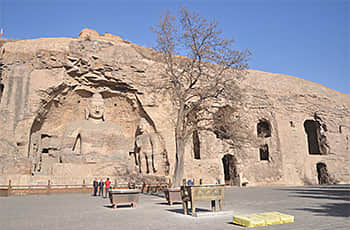 Yungang Grottoes
Yungang Grottoes 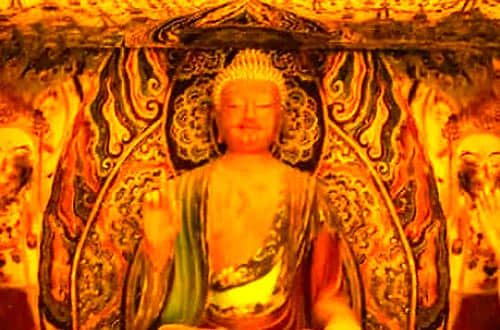 Mogao Caves
Mogao Caves 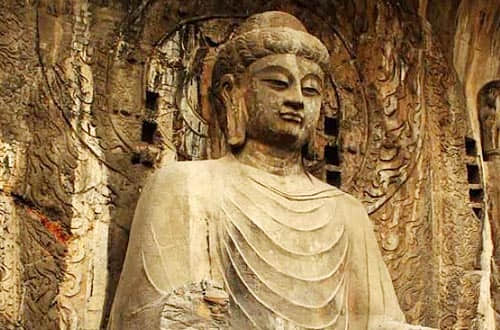 Longmen Grottoes
Longmen Grottoes 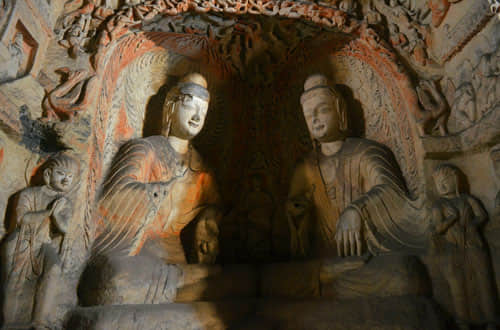 Buddhist Grottoes in China
Buddhist Grottoes in China 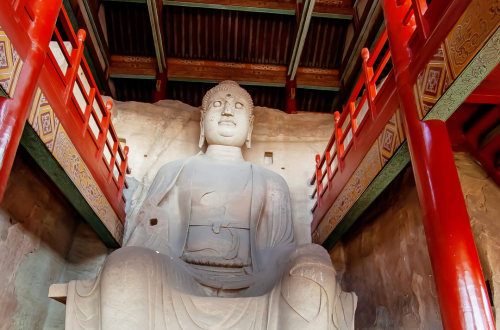 Tianlongshan Grottoes
Tianlongshan Grottoes